|
BRANDS HATCH
Why should the British Grand Prix be held at Brand Hatch?
Ewan M. Tytler: Silverstone, in its original form, was a flat, simple circuit with seven corners linking straights on a bleak, disused airfield in Northamptonshire. Although Silverstone was blindingly fast and has gone through many incarnations, it never captured my imagination. In contrast, Brands Hatch, is set in a natural amphitheatre in picturesque Kent, with a uniquely English up-hill and down-dell character. I always looked forward to seeing the British Grand Prix at "The Hatch".
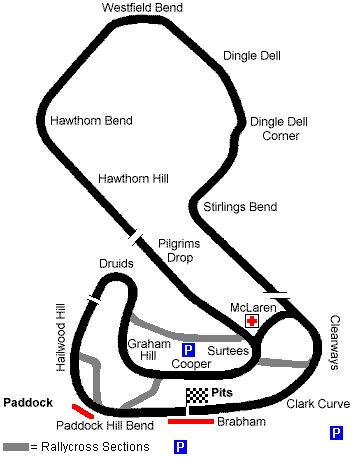 Mark Alan Jones: Where Silverstone's main quality is speed, Brands' was the corners and the huge variety of speeds. Silverstone had numerous straights linked by some fast corners, but by 1994, in the aftermath of Imola, a large number of corners had been chicaned away by the Becketts, Vale, and the Woodcote complexes. Copse has been reprofiled as well - a sharpened entry with a kink after the exit for the run towards Maggots. Mark Alan Jones: Where Silverstone's main quality is speed, Brands' was the corners and the huge variety of speeds. Silverstone had numerous straights linked by some fast corners, but by 1994, in the aftermath of Imola, a large number of corners had been chicaned away by the Becketts, Vale, and the Woodcote complexes. Copse has been reprofiled as well - a sharpened entry with a kink after the exit for the run towards Maggots.
Brands has changed very little since Formula One left and is the jewel in the national/club crown of British circuits. Although it has none of the glamour of Silverstone or the grandeur of Donington, both circuits steeped in British motor racing history, Brands Hatch is a circuit of the brave. The diving, climbing, curving 'Indy' course, and the fast blast through the woods of the Grand Prix loop and the mild insanity of Dingle Dell. Brands Hatch has changed little since 1986. Dingle Dell has been reprofiled twice to improve safety. Westfield has been altered and it is now a double apex right hander. The track is still in regular use for major events: the shorter 'Indy' course is one of the favourite stop-overs of the hard-fought British Touring Car Championship, and the 'Grand Prix' course is used by the World Superbike Championship.
Why did Brands Hatch lose the British Grand Prix in 1986?
Jones: Brands Hatch was dropped because FISA had instituted a policy of long-term contract with circuits. Brands Hatch was perceived as a poorer facility. Brands did have very little run-off and room to expand, something Silverstone has in acres. Silverstone and the BRDC had signed a seven year contract at some point in 1986, to run from 1987 to 1993. It was around the same time the French Grand Prix stopped visiting Dijon-Prenois in favour of a permanent home at Paul Ricard.
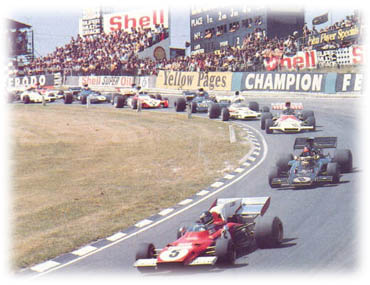 Tytler: Brands Hatch also changed hands in 1986, being was sold to John Foulston who formed the Brands Hatch Leisure Group. Tytler: Brands Hatch also changed hands in 1986, being was sold to John Foulston who formed the Brands Hatch Leisure Group.
Which was safer, Brands Hatch or Silverstone?
Tytler: Silverstone was more dangerous than Brands Hatch. There were two fatal accidents in Formula One Grands Prix at Silverstone: Harry Schell died there in 1960 and Bob Anderson in 1967, both accidents happened in testing under wet conditions. John Foulston, father of Nicola Foulston and then owner of Brands Hatch, was killed while driving a McLaren M23 Formula One
car at Silverstone in 1987. Both circuits have had fairly serious first lap accidents.
Jones: I remember Jacques Laffite's big shunt at the start of the 1986 race when he sustained serious leg injuries that ended his career. This wasn't really a function of the circuit, it almost could have happened anywhere.
Tytler: The only fatal accident at Brands Hatch came in 1971 when Jo Siffert crashed his BRM P160 during the end-of-season Victory Race. Siffert went off the track and hit a bank at Hawthorn's Bend after a suspension failure. His BRM caught fire in front of BBC cameras during a rare live television broadcast. Siffert died from smoke inhalation but BRM didn't learn from this; Clay Regazzoni's BRM P160 also caught fire at Kyalami in 1973. Mike Hailwood saved Regazzoni's life by pulling him from the burning BRM, for which he earned the George Medal for valour.
What changes to the circuit are proposed?
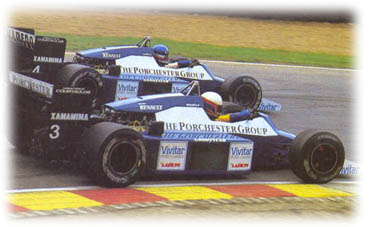 Tytler: The start/finish line will be moved to the new straight beside the new pits and media complex that will be built at Woodlands. The track will be widening at Paddock Hill Bend, which will now be taken at an estimated 200 kmph. The Hawthorn Bend, at the end of the straight, which used to be a fast corner will now become a second gear corner. From Westfield Bend to Dingle Dell will become a series of fast sweeping curves that bypass the original S-bend at Dingle Dell Corner. The straight from Dingle Dell to Clearways has been moved and extended. Clearways has been moved over to join the club circuit earlier, at McLaren, creating a chicane. Tytler: The start/finish line will be moved to the new straight beside the new pits and media complex that will be built at Woodlands. The track will be widening at Paddock Hill Bend, which will now be taken at an estimated 200 kmph. The Hawthorn Bend, at the end of the straight, which used to be a fast corner will now become a second gear corner. From Westfield Bend to Dingle Dell will become a series of fast sweeping curves that bypass the original S-bend at Dingle Dell Corner. The straight from Dingle Dell to Clearways has been moved and extended. Clearways has been moved over to join the club circuit earlier, at McLaren, creating a chicane.
Most of the other changes are safety-ralated. All round the circuit, run-off areas will be widened. Spectator facilities will be expanded and improved by adding temporary grandstands in the circuits natural amphitheatre. More banking, designed to reduce noise, will be added while existing banking will be moved back. The initial feasibility study estimated that the Brands renovation work could be finished in six months. It has been approved by the FIA Safety Commission and the construction work will be carried out by Tilke GmbH, the German company who built Malayasia's Sepang Grand Prix circuit. I understand that the Bank of Scotland will provide loans to finance the Brands Hatch renovations.
what would a lap around the proposed new Brands Hatch be like?
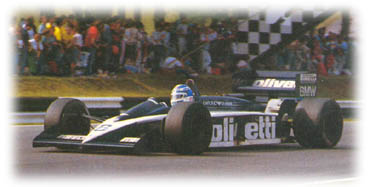 Jones: Starting from the existing start line on Brabham straight, angled, curved and descending - the track climbs up to Paddock Hill, which has recently acquired new sandtraps. The track dives down before climbing Hailwood and into Druids. Druids is the slowest part of the track but the new Clark could challenge that. A sharp and brief descent down to Graham Hill Bend, which was reprofiled this year. The new work improves viewing of the corner from the Brabham Straight grandstands, the entry
is now more of a kink with a sharper exit on to Cooper Straight than the double apex corner it used to be. Cooper once swept into the gradually tightening Surtees where the Indy Course turned right towards Clark Corner. Jones: Starting from the existing start line on Brabham straight, angled, curved and descending - the track climbs up to Paddock Hill, which has recently acquired new sandtraps. The track dives down before climbing Hailwood and into Druids. Druids is the slowest part of the track but the new Clark could challenge that. A sharp and brief descent down to Graham Hill Bend, which was reprofiled this year. The new work improves viewing of the corner from the Brabham Straight grandstands, the entry
is now more of a kink with a sharper exit on to Cooper Straight than the double apex corner it used to be. Cooper once swept into the gradually tightening Surtees where the Indy Course turned right towards Clark Corner.
Surtees continued to tighten before blasting away down the descent down Pilgrim's Drop. Surtees will be much tighter and earlier
blasting on to a new pit straight. The new Surtees/Pit section is reminiscent of Jerez, and should improve the chances of a drag race to the new finish line because Surtees looks tight enough for some serious out-braking duels. The new pit lane will be between the old Pilgrim's Drop straight and the new one - the old straight will be in the new pit paddock area. Blasting past the new pits ,we arrive at the new Hawthorn Corner, in a different location from the old Hawthorn Bend, the new corner is a much sharper 95 to 100 degree right hander. This could be the cause of some first corner pileups.
 The new Derek Minter Straight runs alongside and joins up to the old one just before Westfield Bend, which was re-done last year after the local development started to get too close. Westfield was once a double apex corner that used to blast away towards Dingle Dell. The new track sees the second apex tighten into a new straight before a new right hander two third down and inside
of the old straight. The 100-110 degree right then leads into a short straight before a fast sweeping left. Dingle Dell and Stirlings are completely removed. The straight from Dingle Dell to Stirling is crossed at almost 90 degrees by the new straight which blast all the way back towards Clark Curve. The new Derek Minter Straight runs alongside and joins up to the old one just before Westfield Bend, which was re-done last year after the local development started to get too close. Westfield was once a double apex corner that used to blast away towards Dingle Dell. The new track sees the second apex tighten into a new straight before a new right hander two third down and inside
of the old straight. The 100-110 degree right then leads into a short straight before a fast sweeping left. Dingle Dell and Stirlings are completely removed. The straight from Dingle Dell to Stirling is crossed at almost 90 degrees by the new straight which blast all the way back towards Clark Curve.
Clearways is crossed by the new straight roughly at the middle before linking up with a tight left onto the linking corner between Surtees and Clark which is used for the 'Indy' course. Clark is largely the same but now a slower entry and a different line before the descent down Brabham Straight to the old start/finish.
How will these changes affect the rhythm of Brands Hatch?
Tytler: The revised entrance to Clearways is claimed to be for improving overtaking, but in reality, the momentum of the cars will be lost and overtaking on the Brabham straight and at Paddock Bend, which needed the momentum through Clearways, will be less likely. A grandstand finish with two or more cars sprinting to the new start-finish line is possible, but again most of the car's momentum will be lost by the revised, tighter, Surtees Bend.
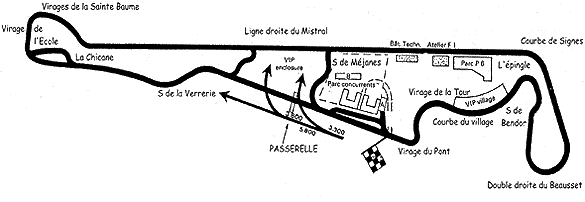 PAUL RICARD
PAUL RICARD
Why should the French Grand Prix move to Paul Ricard?
Tytler: Magny Cours is in the middle of nowhere in France and although it is a safe track, spectators and drivers die of boredom. Paul Ricard, the drink's magnate, finance the building of Circuit Paul Ricard in the hilltop hamlet of Le Camp which forms part of medieval township of Le Castellet in Provence. Paul Ricard is a far better track than Magny Cours. Le Castellet is fast, quite flat and can become dusty.
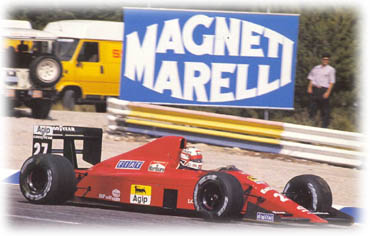 This well-financed circuit had excellent facilities for the teams and the spectators. Now thirty years old, the Paul Ricard circuit has been relegated to truck racing and FIM motorcycle racing. I would rather see the French Grand Prix return to Dijon-Prenois, an open circuit with sweeping bends and many changes in elevation, that was the scene of the greatest French Grand Prix of all time, in 1979. This well-financed circuit had excellent facilities for the teams and the spectators. Now thirty years old, the Paul Ricard circuit has been relegated to truck racing and FIM motorcycle racing. I would rather see the French Grand Prix return to Dijon-Prenois, an open circuit with sweeping bends and many changes in elevation, that was the scene of the greatest French Grand Prix of all time, in 1979.
Jones: The Paul Ricard track is still in use as a testing venue for Formula One teams on occasion - the south coast of France being a relatively nice place to race. It hasn't changed at all since it was last used for Formula One in 1990.
Was Paul Ricard a dangerous circuit?
Jones: When it was first built, Paul Ricard was considered an uninspiring but safe facility, perhaps the safest in Europe.
Tytler: Paul Ricard had a reasonably good safety record by 80's standards. There were only three major accidents at this circuit. During practice in 1985, Nigel Mansell had the worst accident of his career when a rear tyre on his Williams exploded at the end of the 1.6 Km Mistral straight, this tore off the rear wing and the car went off into the catch-fences at the end of the straight. Mansell was knocked unconscious after a fence-post hit him on the head. Mansell was hospitalised and wasn't allowed to compete in the race. Later that year, the FIA banned catch-fences.
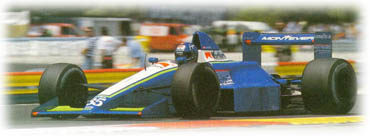 Elio De Angelis was killed in a testing session in 1986. A component broke on his Brabham at the end of the start-finish straight and he went off the track at the kink that was normally taken at 290 kmph. The Brabham caught fire and the marshals could not get to him in time. De Angelis died a few hours later from injuries sustained in the fire. Many commentators have concluded that De Angelis would have lived if this accident had happened during a properly marshalled race. Mauricio Gugelmin, who now races in the North American CART series, destroyed his Leyton-House March in a massive collision at the start of
the 1989 French Grand Prix. The Brazilian's March took off and somersaulting down the track. Unfazed, "Big Mo" then took a spare car, set fastest lap and finished 14th. Again, this could have happened at any circuit. Elio De Angelis was killed in a testing session in 1986. A component broke on his Brabham at the end of the start-finish straight and he went off the track at the kink that was normally taken at 290 kmph. The Brabham caught fire and the marshals could not get to him in time. De Angelis died a few hours later from injuries sustained in the fire. Many commentators have concluded that De Angelis would have lived if this accident had happened during a properly marshalled race. Mauricio Gugelmin, who now races in the North American CART series, destroyed his Leyton-House March in a massive collision at the start of
the 1989 French Grand Prix. The Brazilian's March took off and somersaulting down the track. Unfazed, "Big Mo" then took a spare car, set fastest lap and finished 14th. Again, this could have happened at any circuit.
Why did Paul Ricard lose the French Grand Prix in 1990?
Tytler: Elio de Angelis's death at Paul Ricard was an excuse to move the French Grand Prix to to Magny Cours. This had everything to do with French provincial politics and had little to do with safety. President Mitterand of France was a native of Nevers, where Magny Cours is located. Guy Ligier, the owner of the Ligier team, was an old friend of Mitterand. The Ligier team moved to Magny Cours from Vichy in 1988. The French Finance minister at the time, Pierre Beregovoy, was also the Mayor of Nevers. The French government apparently spent 250 million francs to underwrite the upgrading of the Magny Cours circuit.
What changes are likely to be made to Paul Ricard?
 A statement by the circuit owners read: "Paul Ricard SA, owner of the circuit, and Ricard SA (Pernod Ricard Group) which manages the circuit, came to the conclusion that, after 30 years of intensive activity, the circuit needed to be rebuilt to meet the standards which be required by the motorsport authorities in the years ahead." A statement by the circuit owners read: "Paul Ricard SA, owner of the circuit, and Ricard SA (Pernod Ricard Group) which manages the circuit, came to the conclusion that, after 30 years of intensive activity, the circuit needed to be rebuilt to meet the standards which be required by the motorsport authorities in the years ahead."
Tytler: Following De Angelis's death, the circuit was cut down from 5.808 Km to 3.812 Km. The new owners of Paul Ricard are a company with links to FOCA chief, Bernie Ecclestone. Since Ecclestone works hand-in-glove with FIA President Max Moseley, it is certain that the new owners will follow the FIA safety rules to the letter. Like Brands Hatch, this circuit will need a Grade 1 Circuit Licence to hold a Formula One event.
In 1994 the FIA used computer analysis to identify "very high risk" corners. Paul Ricard will be subject to the same analysis and changes will be made to "very high risk" corners to reduce their risk values. Since Paul Ricard has been used for recent Formula One testing, some data from their onboard data records may be available to help in these tests. Since Ecclestone owned Brabham when De Angelis was killed, it is very likely that he will insist that the kink following the start be classified as "very high risk" and changed accordingly. We can only hope that the FIA has learned from its mistakes in the 80's and 90's
when they created safe but generic circuits that hosted dull races.
| 
 Mark Alan Jones: Where Silverstone's main quality is speed, Brands' was the corners and the huge variety of speeds. Silverstone had numerous straights linked by some fast corners, but by 1994, in the aftermath of Imola, a large number of corners had been chicaned away by the Becketts, Vale, and the Woodcote complexes. Copse has been reprofiled as well - a sharpened entry with a kink after the exit for the run towards Maggots.
Mark Alan Jones: Where Silverstone's main quality is speed, Brands' was the corners and the huge variety of speeds. Silverstone had numerous straights linked by some fast corners, but by 1994, in the aftermath of Imola, a large number of corners had been chicaned away by the Becketts, Vale, and the Woodcote complexes. Copse has been reprofiled as well - a sharpened entry with a kink after the exit for the run towards Maggots.




 PAUL RICARD
PAUL RICARD


